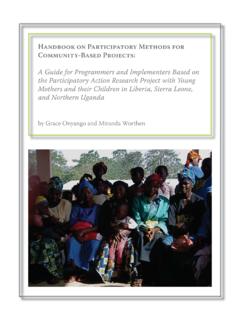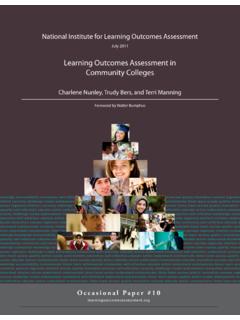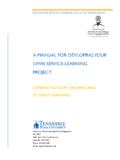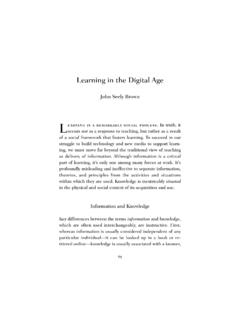Transcription of COMMUNITY-BASED FIRE MANAGEMENT A review
1 ISSN 0258-6150 COMMUNITY-BASED fire MANAGEMENTA reviewCOMMUNITY- based fire MANAGEMENTA reviewFAOFORESTRYPAPER166 Cover photo: xCommunity- based fire MANAGEMENT in Zimbabwe, P. Vuorinen, 2009 COMMUNITY-BASED fire MANAGEMENTA reviewFAO FORESTRYPAPER166 FOOD AND AGRICULTURE ORGANIZATION OF THE UNITED NATIONSRome, 2011 The designations employed and the presentation of material in this information product do not imply the expression of any opinion whatsoever on the part of the Food and Agriculture Organization of the United Nations (FAO) concerning the legal or development status of any country, territory, city or area or of its authorities, or concerning the delimitation of its frontiers or boundaries.
2 The mention of specific companies or products of manufacturers, whether or not these have been patented, does not imply that these have been endorsed or recommended by FAO in preference to others of a similar nature that are not mentioned. The views expressed in this information product are those of the author(s) and do not necessarily reflect the views of 978-92-5-107094-9 All rights reserved. FAO encourages the reproduction and dissemination of material in this information product. Non-commercial uses will be authorized free of charge, upon request. Reproduction for resale or other commercial purposes, including educational purposes, may incur fees.
3 Applications for permission to reproduce or disseminate FAO copyright materials, and all queries concerning rights and licences, should be addressed by e-mail to or to the Chief, Publishing Policy and Support Branch, Office of Knowledge Exchange, Research and Extension, FAO, Viale delle Terme di Caracalla, 00153 Rome, Italy. FAO 2011iiiContentsForeword vAcknowledgements viiAcronyms ixExecutive summary xiIntroduction 1 fire MANAGEMENT concepts, context and system 1 COMMUNITY-BASED fire MANAGEMENT (CBFiM) 3 What is it?
4 4 community 6 Integrated fire MANAGEMENT 7 CBFiM in practice 9 FAO training workshops 13 Learning objectives 13 South Africa (2004) 15 Belize (2005) 15 Indonesia (2007) 16 China (2009) 17 Analysis 17 Governance, policy and legislation 19 Rapid assessment tools 25 Participatory rapid appraisal 25 Ranking, scoring and matrices 25 Analysis tables 26 CBFiM and climate change 29 CBFiM in sum 31 Limiting factors 31 Partners and collaboration 32 Tools and resources 33 References 35ivAnnexes CBFiM case studies 39 Annex 1 - CBFiM in Namibia.
5 The Caprivi Integrated fire MANAGEMENT programme 41 Annex 2 - CBFiM in the United States of America: the High Knob community wildfire protection plan 49 Annex 3 - CBFiM in Mexico: La Sepultura Biosphere Reserve in Chiapas 57 Annex 4 - CBFiM in the Tanami Desert region of central Australia 67 Annex 5 - The Sofala community Carbon Project Gorongosa National Park 79vForewordFor more than 60 years, FAO has made dedicated efforts to strengthen the capacities of member countries in forest fire MANAGEMENT . Over the years, many fire MANAGEMENT projects have been implemented in member countries.
6 Building on the experiences of FAO and others, two complementary approaches to fire MANAGEMENT have been developed. The first is an integrated approach. Integrated fire MANAGEMENT combines science and fire MANAGEMENT with socio-economic elements, at multiple levels. Environmental, cultural, social, economic and political interactions are considered. An integrated approach also looks at all types of vegetation fires, as fires do not stop at the border between one land-use or vegetation type and another. Integrated fire MANAGEMENT requires a balance of many different fire -related activities; rather than being limited to actions involving fire suppression and provision of equipment, it extends to such activities as prevention, awareness-raising, preparedness and restoration.
7 The integrated approach is reflected in the fire MANAGEMENT Voluntary Guidelines published by FAO in 2006. Ideally, this approach would lead to integrated landscape fire MANAGEMENT or integrated natural resource fire second approach is a participatory approach known as COMMUNITY-BASED fire MANAGEMENT . Globally, people cause most fires. Involving the population in all aspects of relevant policy development and fire MANAGEMENT practices is, therefore, a logical approach. Rural communities, especially in developing countries, are often closest to and most affected by vegetation fires. Often they cannot call on distant national agencies to prevent or to fight fires.
8 As a consequence, they have to deal with these fires themselves. Most fire MANAGEMENT projects of FAO focus on this approach. Like integrated fire MANAGEMENT , COMMUNITY-BASED fire MANAGEMENT also promotes activities that extend beyond suppression and provision of equipment to emphasize prevention and preparedness in a landscape fire MANAGEMENT can take different forms. The present publication highlights the state of the art in COMMUNITY-BASED fire MANAGEMENT and provides updated information that complements the approach published previously in the fire MANAGEMENT Voluntary Guidelines. The document redefines the concept, reviews some implementation and training case studies, reflects on related policy and legal frameworks and considers the climate change concept.
9 It draws attention to limitations in: policy and law, capacity, training opportunities, incentives, concept promotion and funding. It concludes with current challenges for COMMUNITY-BASED fire MANAGEMENT , such as:vir IPX UP NBLF UIF BQQSPBDI BO JOUFHSBM DPNQPOFOU JO OBUVSBM SFTPVSDF BOE landscape MANAGEMENT , and in rural development;r UIF EFWFMPQNFOU PG QBSUOFSTIJQT XJUI DPNNVOJUJFT UIF QSJWBUF TFDUPS /(0T governments and their agencies to provide knowledge and resources necessary for effective implementation; andr UIF OFFE UP EJSFDU FYJTUJOH JOGPSNBUJPO BCPVU UIJT BQQSPBDI UP SFTPVSDF managers and end a next step in COMMUNITY-BASED fire MANAGEMENT , and based on this publication, the Forestry Department hopes to produce a tool for practitioners in this field.)
10 To this end we encourage you to provide us with feedback on this Loyche-WilkiePrincipal OfficerForest Assessment, MANAGEMENT and Conservation DivisionFAO Forestry DepartmentviiAcknowledgementsThe first version of this document was produced by Darren Johnson, who began the document under the guidance of FAO Forestry Officer, Petteri Vuorinen, who was later replaced by Pieter van of the CBFiM case studies are: Robin Beatty (Namibia), Darren Johnson and Rachel Brummel (United States of America), Ronald Myers (Mexico) and Gina Braun and Grant Allan (Australia). The case study on a community carbon project (Mozambique) was provided by Darren Johnson, Casey Ryan and Lucy peer review , which included Sophie Grouwels (FAO), Mike Jurvelius (independent consultant), Fred Kafeero (FAO), Peter Moore (independent consultant) and Cesar Sabogal (FAO), resulted in useful recommendations for the final revision and editing, both of which were carried out by Peter maps were designed by Kori COMMUNITY-BASED fire managementCBFM COMMUNITY-BASED forest managementCBNRM COMMUNITY-BASED natural resource managementCLC Central Land Council (Australia)















